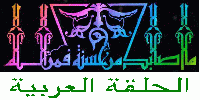![]()
![]()
Arabic on the WWW can be provided in two forms; either as text or as graphics. Arabesque provides a discussion of both approaches. GLSNA's Arabic home page provides a sample of the main aim of The Arabian Oasis, i.e. providing environmental awareness literature in Arabic text form.
![]()
![]()
As you can read this now, there is absolutely no problem in viewing English text. However, if you wander into an Arabic page, you will see something like hieroglyphics. The Arabic text (as well as all none Latin languages) requires use of one of a family of multilingual browsers, all of which are available on free trial basis. The viewing of the traditional 'graphic' Arabic sites, does not require special browsers (if you have the time). However, it is not accessible to Lynx users, unlike the Arabic text.
So, if you wish to see the Arabic text (not the graphics) examples, go ahead follow the links provided, download your free trial copy of a multilingual browser (or plug-in). Keep the address of this page in your bookmarks, or favourites. Get off the Internet, install it and come back again.

This site can optionally be viewed by the following browsers:
For more information about reading Arabic text HTML visit Professor Nicholas Heer's web page
![]()
View The Arabian Oasis Guestbook
Sign The Arabian Oasis Guestbook

![]()
Partners and competitors in the Arabization of the WWW
Thank you
![]()
The problem is that I could not view it using either AccentSoft Multilingual Browser and/or Netscape Navigator Gold with the AccentSoft "Navigate with an Accent" plug-in. This is one of the problems confronted in Arabic text pages; lack of adherence to international standards. Byte Middle East uses 3 different HTML scripts to satisfy almost all needs, depending on automatic detection of the browser used. I do not know what is worse, adopting multiple 'formats' or presenting Arabic as graphics?
![]()

![]()
![]()

|
This Arabic site of FITS click for next | next 5 | skip or join the Arabic Text Ring |
|||
![]()
Arabic in graphic form cannot be justified nowadays. It is more expensive for the publisher and for the user who usually pays by the minute. It is almost completely useless when it comes to re-using it. For complete discussion of the issue read Arabesque.
The only exception is its use in Quran (the Muslims' holly book), for the need of Tashkeel, which is still a problem for Arabic text internet publishing. Though Arabic word-processing programs, including Accent Multilingual Publisher, can produce such text, yet when converted to HTML, these special characters taks a space by itself, destroying the continuity of the Arabic words. However, as demonstrated by Professor Nicholas Heer, this has been overcome.
The dependence on graphics also excludes lynx users from the Arabic information. Adherence to the ISO-8859/6 Arabic code should be the standard.
![]()
If you have links to pages in Arabic text, please contact me fits@servtech.com
![]()